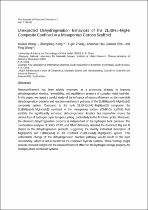 ResearchSpace
ResearchSpace
Unexpected dehydrogenation behaviors of the 2LiBH4-MgH2 composite confined in a mesoporous carbon scaffold
JavaScript is disabled for your browser. Some features of this site may not work without it.
- ResearchSpace
- →
- Research Publications/Outputs
- →
- Journal Articles
- →
- View Item
| dc.contributor.author |
Wang, K

|
|
| dc.contributor.author |
Kang, X

|
|
| dc.contributor.author |
Zhong, Y

|
|
| dc.contributor.author |
Hu, C

|
|
| dc.contributor.author |
Ren, Jianwei

|
|
| dc.contributor.author |
Wang, P

|
|
| dc.date.accessioned | 2015-03-12T09:57:29Z | |
| dc.date.available | 2015-03-12T09:57:29Z | |
| dc.date.issued | 2014-11 | |
| dc.identifier.citation | Wang, K, Kang, X, Zhong, Y, Hu, C, Ren, J and Wang, P. 2014. Unexpected dehydrogenation behaviors of the 2LiBH4-MgH2 composite confined in a mesoporous carbon scaffold. The Journal of Physical Chemistry C, vol. 118(46), pp 26447-26453 | en_US |
| dc.identifier.issn | 1932-7447 | |
| dc.identifier.uri | http://pubs.acs.org/doi/pdf/10.1021/jp505535h | |
| dc.identifier.uri | http://hdl.handle.net/10204/7924 | |
| dc.description | Copyright: 2014 ACS Publishing.Due to copyright restrictions, the attached PDF file only contains the abstract of the full text item. For access to the full text item, please consult the publisher's website. | en_US |
| dc.description.abstract | Nanoconfinement has been widely employed as a promising strategy to improve dehydrogenation kinetics, reversibility, and equilibrium pressure of complex metal hydrides. In this paper, we report a careful study of the influence of nanoconfinement on the reversible dehydrogenation property and reaction mechanism pathway of the 2LiBH(sub4)–MgH(sub2) composite system. Compared to the bulk 2LiBH(sub4)–MgH(sub2) composite, the 2LiBH(sub4)–MgH(sub2) confined in the mesoporous carbon (CMK-3) scaffold host exhibits the significantly enhanced dehydrogenation kinetics but meanwhile shows the serious loss of hydrogen capacity upon cycling, particularly in the first two cycles. Moreover, the observed dehydrogenation property is independent of the hydrogen back pressure. The combination analyses of XRD, FTIR, and NMR definitely detected the dominant Mg and B phases in the dehydrogenation products, suggesting the mainly individual desorption of MgH(sub2) and LiBH(sub4) in the confined 2LiBH(sub4)–MgH(sub2) system. This unfavorable change of the dehydrogenation reaction pathway would result in the poor reversibility, which is not expected for the combined hydride systems. These findings might provide renewed insight into the nanoconfinement effect on the hydrogen storage property for multiple phase combined systems. | en_US |
| dc.language.iso | en | en_US |
| dc.publisher | ACS Publishing | en_US |
| dc.relation.ispartofseries | Workflow;14191 | |
| dc.subject | Nanoconfinement | en_US |
| dc.subject | Dehydrogenation | en_US |
| dc.subject | Hydrogen storage | en_US |
| dc.title | Unexpected dehydrogenation behaviors of the 2LiBH4-MgH2 composite confined in a mesoporous carbon scaffold | en_US |
| dc.type | Article | en_US |
| dc.identifier.apacitation | Wang, K., Kang, X., Zhong, Y., Hu, C., Ren, J., & Wang, P. (2014). Unexpected dehydrogenation behaviors of the 2LiBH4-MgH2 composite confined in a mesoporous carbon scaffold. http://hdl.handle.net/10204/7924 | en_ZA |
| dc.identifier.chicagocitation | Wang, K, X Kang, Y Zhong, C Hu, Jianwei Ren, and P Wang "Unexpected dehydrogenation behaviors of the 2LiBH4-MgH2 composite confined in a mesoporous carbon scaffold." (2014) http://hdl.handle.net/10204/7924 | en_ZA |
| dc.identifier.vancouvercitation | Wang K, Kang X, Zhong Y, Hu C, Ren J, Wang P. Unexpected dehydrogenation behaviors of the 2LiBH4-MgH2 composite confined in a mesoporous carbon scaffold. 2014; http://hdl.handle.net/10204/7924. | en_ZA |
| dc.identifier.ris | TY - Article AU - Wang, K AU - Kang, X AU - Zhong, Y AU - Hu, C AU - Ren, Jianwei AU - Wang, P AB - Nanoconfinement has been widely employed as a promising strategy to improve dehydrogenation kinetics, reversibility, and equilibrium pressure of complex metal hydrides. In this paper, we report a careful study of the influence of nanoconfinement on the reversible dehydrogenation property and reaction mechanism pathway of the 2LiBH(sub4)–MgH(sub2) composite system. Compared to the bulk 2LiBH(sub4)–MgH(sub2) composite, the 2LiBH(sub4)–MgH(sub2) confined in the mesoporous carbon (CMK-3) scaffold host exhibits the significantly enhanced dehydrogenation kinetics but meanwhile shows the serious loss of hydrogen capacity upon cycling, particularly in the first two cycles. Moreover, the observed dehydrogenation property is independent of the hydrogen back pressure. The combination analyses of XRD, FTIR, and NMR definitely detected the dominant Mg and B phases in the dehydrogenation products, suggesting the mainly individual desorption of MgH(sub2) and LiBH(sub4) in the confined 2LiBH(sub4)–MgH(sub2) system. This unfavorable change of the dehydrogenation reaction pathway would result in the poor reversibility, which is not expected for the combined hydride systems. These findings might provide renewed insight into the nanoconfinement effect on the hydrogen storage property for multiple phase combined systems. DA - 2014-11 DB - ResearchSpace DP - CSIR KW - Nanoconfinement KW - Dehydrogenation KW - Hydrogen storage LK - https://researchspace.csir.co.za PY - 2014 SM - 1932-7447 T1 - Unexpected dehydrogenation behaviors of the 2LiBH4-MgH2 composite confined in a mesoporous carbon scaffold TI - Unexpected dehydrogenation behaviors of the 2LiBH4-MgH2 composite confined in a mesoporous carbon scaffold UR - http://hdl.handle.net/10204/7924 ER - | en_ZA |





